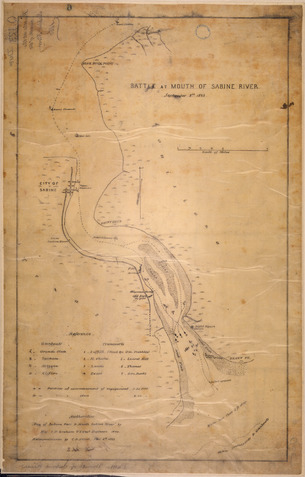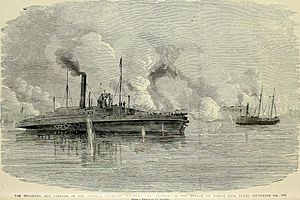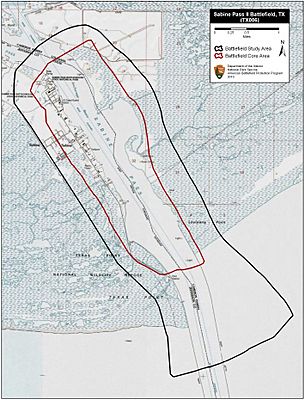Second Battle of Sabine Pass facts for kids
Quick facts for kids Second Battle of Sabine Pass |
|||||||
|---|---|---|---|---|---|---|---|
| Part of the Trans-Mississippi Theater of the American Civil War |
|||||||
 Drawing of the battle |
|||||||
|
|||||||
| Belligerents | |||||||
| Commanders and leaders | |||||||
| William B. Franklin Frederick Crocker |
Richard W. Dowling Leon Smith |
||||||
| Units involved | |||||||
| West Gulf Blockading Squadron | Company F ("Jeff Davis Guards"), 1st Heavy Artillery Regiment | ||||||
| Strength | |||||||
| 5,000 infantry 4 gunboats 18 transports |
46 infantry + 4 reinforcements 6 artillery pieces 1 fort |
||||||
| Casualties and losses | |||||||
| Over 350 killed, wounded, or captured 2 gunboats captured |
None | ||||||
The Second Battle of Sabine Pass happened on September 8, 1863. It was a failed attempt by the Union Army to invade the state of Texas during the American Civil War. The Union Navy helped in this effort. They lost three gunboats during the battle. Two were captured, and one was destroyed.
Many people say this was the most one-sided Confederate victory of the war. This means the Confederates won easily with very few losses. Confederate President Jefferson Davis even called it "the most remarkable in military history" in 1876.
Contents
Why the Battle Happened
France showed support for the Confederate States of America early in the Civil War. After French forces defeated Mexican forces in 1863, the French put Maximilian in charge of Mexico. This meant a French-controlled government was now next to Texas.
The Confederates hoped to trade with Mexico through this new government. They needed supplies badly. President Abraham Lincoln knew about these plans. He sent an army to Texas to stop any trade between the Confederates and Mexico.
General Nathaniel P. Banks led the Union forces. His first plan was to attack in northwest Louisiana. However, the water levels in the Red River were too low. This made it hard for Union gunboats to move. So, the land invasion of Texas was delayed.
General Banks then ordered his officer, Major General William B. Franklin, to attack the Sabine River area. This attack would come from the Gulf of Mexico. The goal was to defeat a small Confederate group at "Fort Sabine." This fort was on the Texas side of the river, about 2 miles (3.2 km) from the river's mouth.
Union Attack Plan
The Union Army planned for their Navy gunboats to first silence the cannons at Fort Sabine. After the fort's guns were quiet, about 200 Union soldiers would land. They would take over the fort.
The main Union fleet was less than five miles offshore. It was too far for Confederate cannons to reach. This fleet had about 20 ships. They carried as many as 5,000 Union soldiers. A small group of artillery was also included.
The first group of soldiers would then take Sabine City. This was a small town nearby. After the main force landed, they would march north. Their goal was to cut the railroad between Houston and Beaumont. Then, they would attack Beaumont. This would stop blockade runners from using Sabine Pass.
The Union forces were much larger than the Confederates. So, taking control of Sabine Pass seemed like an easy task. To keep Confederate forces in Louisiana busy, a Union division moved to Morganza. This led to another battle called the Battle of Stirling's Plantation.
Confederate Defenders
Fort Sabine had been renamed "Fort Griffin." It was named after an earlier commander, Lt. Colonel W. H. Griffin. The Union maps did not show this new name.
The Confederate soldiers at Fort Griffin were called the "Jeff Davis Guards." They were mostly Irish-American men from Houston and Galveston. They had recently joined the First Texas Heavy Artillery.
When the battle started on September 8, 1863, there were 46 men at the fort. Most of them were from the Davis Guards. Lieutenant Richard W. Dowling was their commander. The Davis Guards had six old cannons on the fort's platform.
The fort's position was high. This gave them a clear view for many miles. They could see the flat marshlands in all directions. The nearest place to observe Fort Griffin was the Sabine Pass Lighthouse in Louisiana.
The Battle Begins
On the afternoon of September 8, 1863, U.S. Navy Lieutenant Frederick Crocker led the Union advance squadron. This group had four gunboats. Crocker was an experienced officer. His ship was the USS Clifton. The other ships were Granite City, Sachem, and Arizona. These were all ironclad warships.
Less than three miles downriver, seven Union transport ships waited. They carried most of the Union Army soldiers. The U.S.S. Suffolk carried Major General Franklin, the invasion commander. Even further out, the rest of the 22-ship invasion fleet waited.
The Union plan was for the Granite City to carry 500 soldiers. These soldiers would land after the fort's guns were silenced. This was planned to be the largest amphibious assault in U.S. military history at that time.
Meanwhile, Leon Smith was in Beaumont, Texas. He ordered 80 Confederate troops to reinforce Fort Griffin. Smith and Captain Good rode to the fort on horseback. They arrived just as the Union gunboats USS Clifton and Sachem came into range. They helped defend the fort.
Lieutenant Dowling's artillerymen were well-trained. They had placed white-painted stakes in the river channels. These stakes helped them figure out the exact distance to their targets. This allowed them to aim their six old cannons very accurately.
The Union squadron did not have local river pilots. They only had old maps. They did not know about the changing depths of the river. As the Union ships came into range, the Confederates opened fire.
Despite their old cannons, the Confederate artillerymen's training paid off. Their aim was incredibly accurate.
The Confederates captured the Clifton and Sachem. They also took 13 heavy cannons from these ships. The Union forces had about two dozen killed or wounded. About 37 were missing, and 315 Navy men were captured. The Union invasion force then left and returned to New Orleans. The Confederates had no casualties at all.
What Happened Next
The Confederate Congress thanked the officers and men of the Davis Guard for their victory. People in Houston also raised money to give medals to the Guard. These Davis Guards Medals were made from silver Mexican coins. They had the battle name and date on one side. The other side had the initials "D G" and a cross. The medals were given out in a public ceremony a year later.
The Battle of Sabine Pass was important because it stopped the Union from invading Texas by land. A Confederate supply line from Mexico had existed since the war began. However, the Union victory at Vicksburg in July 1863 made it hard to get supplies across the Mississippi River. So, the Confederacy still had to rely on blockade runners to bring in important materials.




